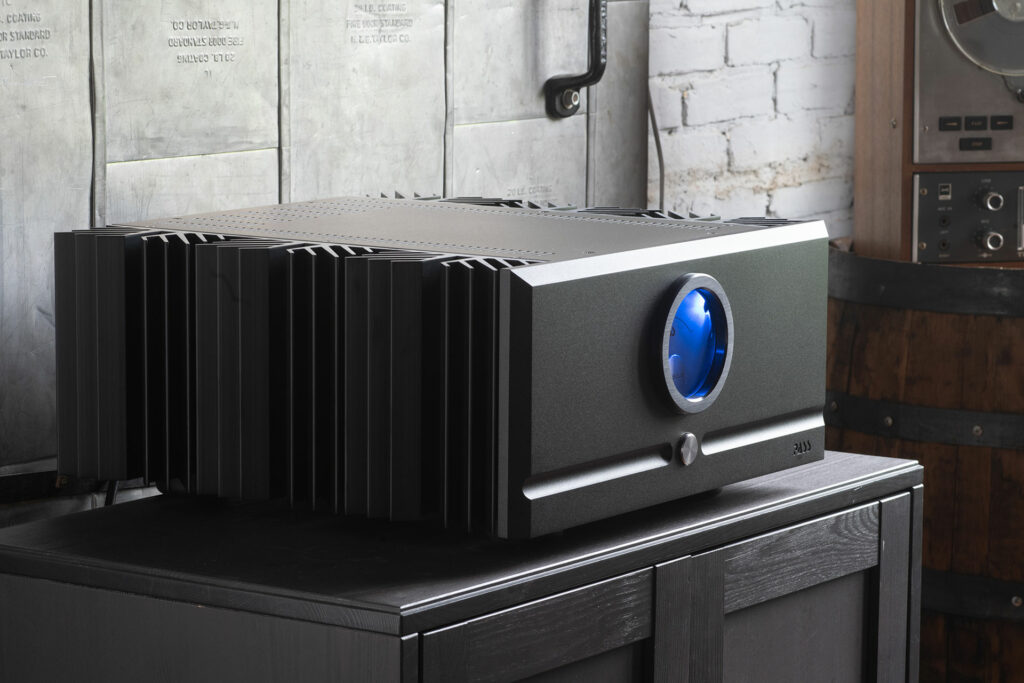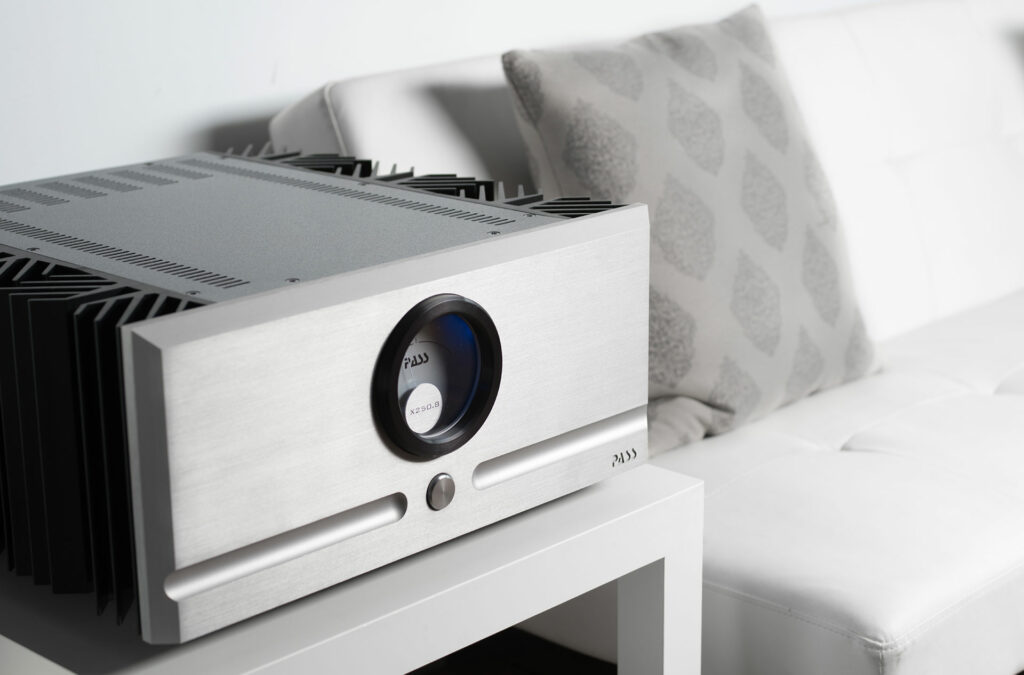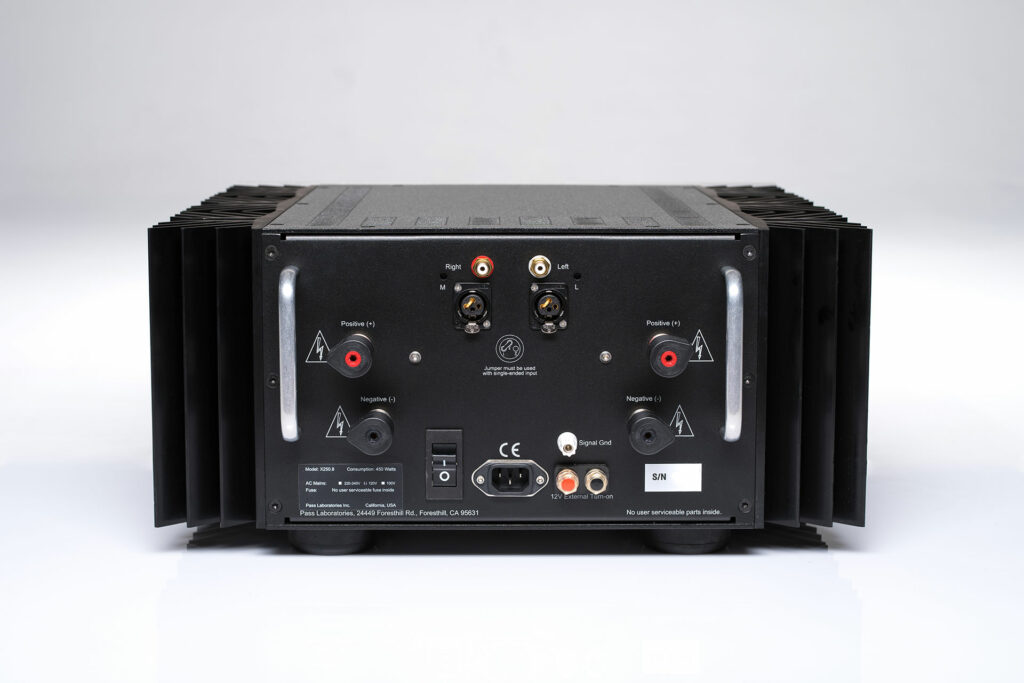If there is anything that seems patently obvious about Nelson Pass, it may be reasonably said he loves designing audiophile amplifiers. Additionally, his company has one of the best reputations in the industry of doing so with magnificent results. Whereas many companies, for any number of reasons, shy away from full Class A-only amp designs, Pass Labs has six mono and two stereo versions. Even the Class AB amps, which includes the Pass Labs X250.8 reviewed herein, is biased to initially function in Class-A and then switch over to Class-AB operation.
Pass Labs as a company seems very content to manufacture a wide range of amplifiers in a wide variety of output wattages, operational bias and cost parameters. For the most part, Pass Labs amps are large, heavy, and look and feel like a high-end audiophile component. Many might allow that Pass Labs amps look like an amp should look. In fact, Pass Labs has one of the best reputations for building exceptional amplifiers, line stage preamps and phono preamplifiers in the business. The Pass Labs X250.8 represents one of those efforts.

What Makes the Pass Labs X250.8 Power Amp So Special?
- The Pass Labs X250.8 is rated for 250 watts per channel (WPC) at eight ohms and 500 WPC at four ohms. Full Class A bias occurs through about the first 14 watts and then switches to Class AB. Pass Labs feels this design offers the best overall sonics, yet will still drive even the most difficult loads where required.
- The fairly large, nicely lit blue meter on the front shows when the amp is operating in Class A and when it ultimately moves into Class AB operation. It does not have calibrations for wattage output. This eliminates any guesswork in how the amp is operating.
- A front-mounted stand-by button allows easy power on/off selection. Many people leave their Pass Labs amps on all of the time, but they (especially the more Class-A specific amps) draw a lot of power from the wall and create a lot of heat, thus others turn their Pass Labs amp off when not in use.
- Large, side-mounted heatsinks provide cooling – something especially important when operating in Class A mode. This was cool on Threshold amps back in the day, and is still cool today.
- On the rear of the enclosure are input connections for both XLR and RCA. Some less expensive amps, like the Pass Labs XA-25 that Jerry Del Colliano uses as his reference, don’t have balanced inputs, but the X250.8 does.
- Pass Labs includes a set of gold jumpers, which are used when connecting unbalanced or RCA cables. In order to use an XLR cable, the jumpers must be removed. These jumpers should not be discarded when not in use. as the intent is to use them for RCA connections.
- Speaker connections are made with easy-to-turn terminals, which will accept bare wire and/or both spade and banana connections concurrently. There is a convenient “click” when the speaker terminal has been sufficiently tightened, thus preventing stripping out the threads or over-torquing the speaker terminals. This dual connection method makes it convenient to connect a set of mains, as well as a subwoofer(s) to the amp.
- Also on the back are two very convenient rack handles, which makes carrying the amp more manageable. At a weight of 100 pounds, this makes moving this amp (in my case upstairs) much easier.
- The “(point) .8” designation represents the most recent technological refinements of the “X” series of amplifiers. These refinements include an increase in the Class A, push-pull operation designed to reduce distortion. Additionally, there are an increased number of higher power MOSFETs than in previous designs, which serve to provide increased capacity of and improve Class A operation.
- Pass Labs doesn’t feel pressure to upgrade their electronics, unless there is a reason. More consumer-grade electronics, like AV receivers, for example, are updated all of the time. Pass Labs get upgrades when Nelson Pass and Wayne Colburn (the guy who designs their insanely good stereo preamps, like the Pass Labs XP-12 and Pass Labs XP-22, and the Pass Labs XP-17 and Pass Labs XP-27 phono stages) feel like there is a reason to change products not because of marketing pressure. This helps retain value in the components over time.
Why Should You Care About the Pass Labs X250.8 Stereo Amp?
In the audiophile hobby, reputation matters. In our little corner of the world, new companies and newfangled ideas seem to come and go with impunity. Pass Labs is a legacy manufacturer with an eye on the past and a purposeful mind towards the future. There is an old-school, “this is how we build ‘em” vibe in their component design, particularly amplifiers. New designs are only introduced when something worthwhile is approved for production. The Pass Labs X250.8 represents nearly 10 years of painstaking development and refinement. Perhaps most uniquely, what is an important part of the final design is making changes based on listening tests by real audiophiles. When buying a Pass Labs amp, the consumer may be assured the design of their purchase is the most current and has been approved by those who use the same gear themselves – audiophiles.

Some Things You May Not Like About the Pass Labs X250.8
- This amp is really heavy. While the rear mounted handles are extremely helpful, moving this amp around for any distance is best accomplished with two people. Don’t be a hero and try to lift a Pass Labs X250.8 by yourself. Hell, make your dealer move it around, as they will be more than happy to help.
- Care should be taken when picking this amp up by the sides. The side mounted cooling fins may cause injury if your hands are not protected. Whenever possible, moving this amp is best accomplished by the rear-mounted rack handles and the faceplate – not the heatsinks.
- Because of its Class A operation, it is subject to operational heat issues consistent with all such amplifiers. Pass Labs recommends a minimum of six inches of clearance on the top, front and all three sides. They highly suggest the amp not be rack mounted. For my purposes, amps always sit on a Symposium Super Plus Platform in front of my audio rack, so adequate cooling was not an issue. While it was slightly more than warm to the touch, it was not hot. In any event, anyone with space limitations should consider heat before planning to rack mount this amplifier.
Listening to the Pass Labs X250.8 Audiophile Power Amplifier …
Before I conducted any serious listening, I loaded about two days’ worth of music and let the system play for about a day and a half. When I subsequently settled into the listening chair, I was treated to an amp I felt had reached thermal stability and would sound its best. Bass response was sufficiently tight and precise. And frankly, this was something I expected to hear from an amp of this caliber. Mids and highs were not drowned out by the low frequencies, and were sufficiently dynamic to be more than just noticeable. Perhaps somewhat surprising was the transient response on the Pass Labs X250.8. They were more than just here and gone, they were a noticeable part of the musical presentation. From a frequency and even a dynamics standpoint, I found no major faults with the Pass Labs X250.8.
If I had one area of contention, it would be image presentation. I would have liked to have heard the imaging presented on a wider scale on a linear, side to side basis. My current reference fills the maximum width of 22 feet from side to side along the long walls of my audio room. However, while the Pass Labs X250.8 did not, this is only a minor issue and certainly not something I found highly objectionable. I only mention it as a deviation from what I consider to be my normal sonic presentation. Clarity and accuracy with the Pass Labs X250.8 in my system were both outstanding. In total, I was very impressed with the sonics in my listening room with this amplifier at the helm. When considering its retail price, its performance is even more impressive.
For a band preeminently known for gripping rock and roll, and some may even classify their music as heavy metal, “The Rain Song” from the fifth Led Zeppelin album Houses of the Holy is out of their norm, and is a sweeping and sometimes tender ballad. While not typically characteristic of their style, Robert Plant simply shines on vocals. And the intro, a simple guitar, if, that is, you consider Jimmy Page’s outstanding guitar work simple, was very soon joined by orchestration ably performed by John Paul Jones by means of a Mellotron. The genius of this track is the complex instruments used to make it sound so very melodic and simple, yet belying the complexity of how it was orchestrated. With the Pass Labs X250.8, I was able to hear all the nuances and subtle shifts, especially at about the five minute mark, when Robert Plant starts singing like Robert Plant, that is, he lets it go with the ferocity for which he is well known. And when the dynamics also began to increase, the X250.8 was easily able to deliver a presentation worthy of a band at their peak.
Love At The Greek was a live recording of the landmark performance at the Greek Theater in 1977 by one of my all-time favorite artists, Neil Diamond. Following the 15:43 minute medley of songs on the “Jonathan Livingston Seagull” track comes the final song (from the album’s perspective anyway), “I’ve Been This Way Before.” I have heard this track countless times. and Diamond’s voice never fails to impress. Combining keyboards with the magnificent drum work by longtime Diamond bandmate Dennis St. John, the dynamics of the percussion section positively explode. This is particularly true when at the 3:14-minute mark Diamond announces, “Thank you, L.A., you’ve been fantastic” and, while the crowd amps up the applause, the drum roll by St. John is one of my favorites. I have been known to increase the amplitude by any number of clicks when this drum roll takes place. And of course, I did so with the Pass Labs X250.8 in the system. And no, it did not disappoint, portraying this passage with all the intensity to which I have been accustomed since the end of the 1970s. I was also able to easily discern the vibrato in Diamond’s voice which, if portrayed on a system lacking sufficient detail, will not be heard. All in all, I noticed no perceptible difference in this track with the Pass Labs X250.8 than the thousands of other times I have played one of my all-time favorite songs.
What Other Amps Compete with the Pass Labs X250.8?
Reviewed by our publisher Jerry Del Colliano is the Classé Delta Stereo Amplifier. Retailing for $12,999, it is slightly more expensive than the Pass Labs X250.8, but in the world of amplifiers, not by a big margin. Classé also operates in Class A for about the first dozen or so watts, then switches to Class AB. It is also rated at 250 WPC at eight ohms. It is both larger and heavier than the Pass Labs X250.8, which may or may not matter, depending on where it is located. Let’s face it, amps are generally not moved very often once put in a permanent position. Like the Pass Labs amp, the Classé Delta Stereo amp has been widely praised by numerous reviews, but the news is that Classé has lost their head executive (he is now the CEO of T+A electronics in the United States), as well as closing their Montreal design offices. Masimo is the medical services company that owns the brand Classé, as well as Bowers Wilkins, Polk, Definitive Technology, Denon and Marantz.
Since first introduced in the late 1950s, McIntosh Labs still uses their patented Autoformer technology, which delivers a steady, consistent power output into a two ohm, four ohm or eight ohm load. Retailing for $10,000 is the McIntosh MC462-2 Solid State Amp, rated at 450 WPC. Recent design changes now allow for more headroom, which translates into greater dynamic range. Another interesting change is a power management feature, which turns off the unit when, for a preset time limit, the amp is not in use. The famed blue meters are now long life LED, which replace the fluorescent bulbs used for many previous decades.
Even though this is not completely fair, I could not help comparing the Pass Labs X250.8 to my reference T+A A3000HV (reviewed here). At nearly three times as expensive, the T+A A3000HV is, on paper, superior in practically every way. With the HV series high voltage rail technology, the T+A amp is designed to resemble the sound of a great tube amplifier. The A3000HV operates in full Class-A operation through about the first 40 watts. Likewise, the sonics of the T+A A3000HV are magnificent. With excellent bass, incredible clarity, robust dynamics and effortless power, this is a serious amplifier which did, in fact, and not surprisingly, outclass the Pass Labs X250.8. Given the significant discrepancy in retail cost, it should have.
Remarkably, however, the Pass Labs more than held its own in my listening tests. What is glaringly obvious is the overall design effort into the X250.8 just works. Using actual audiophiles to critique the sonics allows Pass Labs to make real world changes, which yield a better listening experience. In my system, even though on paper it could have technically been considered a weak link in the chain, the Pass Labs X250.8 performed exceptionally well. In fact, I found very little I did not like about this amplifier. A legitimate question is, how would some of Pass Labs better and more expensive amps perform against my T+A A3000HV? Interesting question.

Does the Pass Labs X250.8 Amp Hold Its Value?
I suspect there are very few companies with a better history for resale value than Pass Labs. Because they concentrate predominately on the design and manufacture of amps, linestage preamps and phono preamps, Pass Labs products fare very well on the used market. As such, they normally sell very quickly on any of the more popular sites and outlets for pre-owned gear. As is my custom, I looked online for a used Pass Labs X250.8 and, at the time of compiling information for this review, I could not find any for sale used. Hold its value? Absolutely and without question.

Final Thoughts on the Pass Labs X250.8 Stereo Amplifier …
Given the price, I could not help but be highly impressed by this amplifier. I can confidently state I feel it punched well above its weight class. I was surprised, given my normal level of components, at how well the Pass Labs X250.8 performed. It had more than adequate slam and dynamic punch. There was a visceral weight to bass management and acceptable low frequency presentation. Mids and highs were presented with no sense of compression, and with a more than adequate level of dynamic linearity.
I also loved the round front meter. And honestly, at first, I felt like I would have preferred seeing the actual wattage output, rather than operating in Class A as opposed to Class AB. However, I quickly, almost immediately, in fact, really enjoyed seeing how long it took and at what amplitude any one particular track crossed over into AB operation – if at all. The meter is but one well-thought-out design feature of the Pass Labs X250.8 amp.
Put simply, the Pass Labs X250.8 is yet another in the long line of excellent products that began in Nelson Pass’s kitchen, and are now available from the talented folks at their Auburn, California facility. If an amplifier with a retail cost of $10,500 is in any way a consideration, a very determined and detailed evaluation of this amplifier is highly recommended. I was impressed by this amp and consider it to be an outstanding value, given the performance. It is also a statement piece from a designer and a company with several decades of highly regarded products. And even if a new amp is not presently in the cards, give a listen to the Pass Labs X250.8 anyway. You’ll see and hear what I mean.




It may be worth noting the XA-25 is single ended topology where the X250.8 is differentially balanced.
You have to love those speaker connectors, my favorite of those I’ve seen/used.
How the world has changed. At one end of the HiFi amplifier spectrum $100 chip based Class-D amplifiers are praised for sound quality, at the other end $10,000 discrete amplifiers are improved close to perfection. On a whim (I believe I’ve waited long enough) I’m going to try a >$100 Class-D ampifier just see what the fuss is all about.